The Intel Skylake-X Review: Core i9 7900X, i7 7820X and i7 7800X Tested
by Ian Cutress on June 19, 2017 9:01 AM ESTBenchmarking Performance: CPU Rendering Tests
Rendering tests are a long-time favorite of reviewers and benchmarkers, as the code used by rendering packages is usually highly optimized to squeeze every little bit of performance out. Sometimes rendering programs end up being heavily memory dependent as well - when you have that many threads flying about with a ton of data, having low latency memory can be key to everything. Here we take a few of the usual rendering packages under Windows 10, as well as a few new interesting benchmarks.
Corona 1.3
Corona is a standalone package designed to assist software like 3ds Max and Maya with photorealism via ray tracing. It's simple - shoot rays, get pixels. OK, it's more complicated than that, but the benchmark renders a fixed scene six times and offers results in terms of time and rays per second. The official benchmark tables list user submitted results in terms of time, however I feel rays per second is a better metric (in general, scores where higher is better seem to be easier to explain anyway). Corona likes to pile on the threads, so the results end up being very staggered based on thread count.
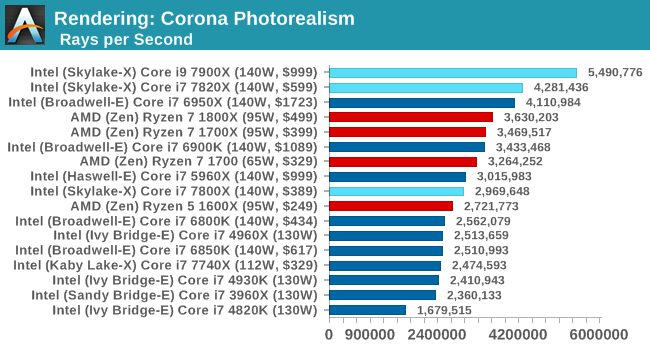
Blender 2.78
For a render that has been around for what seems like ages, Blender is still a highly popular tool. We managed to wrap up a standard workload into the February 5 nightly build of Blender and measure the time it takes to render the first frame of the scene. Being one of the bigger open source tools out there, it means both AMD and Intel work actively to help improve the codebase, for better or for worse on their own/each other's microarchitecture.
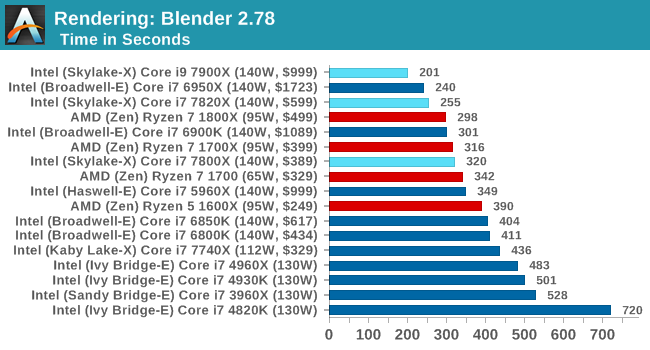
LuxMark
As a synthetic, LuxMark might come across as somewhat arbitrary as a renderer, given that it's mainly used to test GPUs, but it does offer both an OpenCL and a standard C++ mode. In this instance, aside from seeing the comparison in each coding mode for cores and IPC, we also get to see the difference in performance moving from a C++ based code-stack to an OpenCL one with a CPU as the main host.
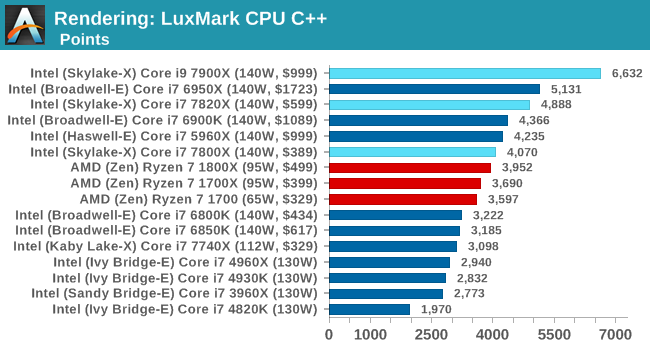
POV-Ray 3.7b3
Another regular benchmark in most suites, POV-Ray is another ray-tracer but has been around for many years. It just so happens that during the run up to AMD's Ryzen launch, the code base started to get active again with developers making changes to the code and pushing out updates. Our version and benchmarking started just before that was happening, but given time we will see where the POV-Ray code ends up and adjust in due course.
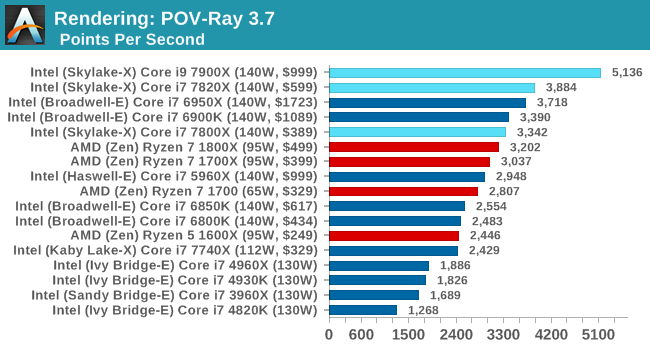
Cinebench R15
The latest version of CineBench has also become one of those 'used everywhere' benchmarks, particularly as an indicator of single thread performance. High IPC and high frequency gives performance in ST, whereas having good scaling and many cores is where the MT test wins out.
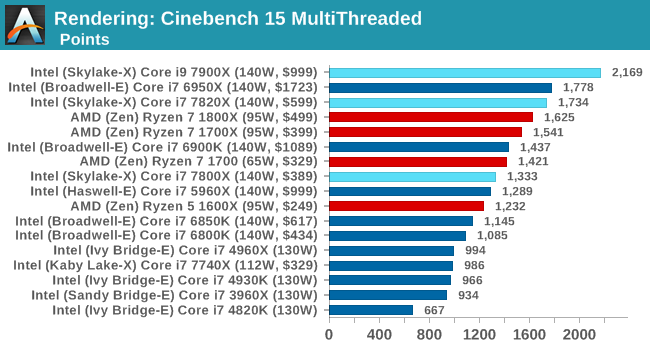
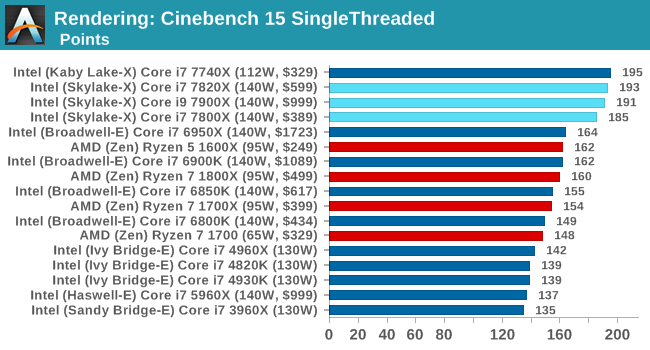










264 Comments
View All Comments
jjj - Monday, June 19, 2017 - link
The 10 cores die is clearly 320+mm2 not 308mm2. The 308mm figure rounds down the mm based on those GamerNexus pics. From there, you slightly underestimate the size of other 2 die.Sarah Terra - Monday, June 19, 2017 - link
Fair point but what I take from this review is that you are going to be spending pretty much double the cost or higher of ryzen for a proc that will have a 30% larger power envelope if you want higher performance. Intel is scrambling here, well done AMD.jjj - Monday, June 19, 2017 - link
With 8 cores and up, thermal is a big issue when you OC Skylake X.. Power also to some extent.The 6 cores looks interesting vs the 7700k but not so much vs anything else. CPU+mobo gets you north of 600$ and that's a lot. If it had all the PCIe lanes enabled, there would be that but ,while plenty will buy it, it makes no sense to. And ofc there should be a Coffee Lake 6 cores soon , we'll see how it is priced- in consumer 6 cores with 2 mem chans is fine.
More than 6 cores are priced way too high and , if you need many cores, you buy for MT not ST so ST clocks are less relevant.
Intel moving in the same direction as AMD on the cache size front is interesting- larger L2 and smaller L3. Now they have "huge cache and memory latency issues"" just like Ryzen lol.
W/e, Intel's pricing is still far too high and this platform remains of minimal relevance.
ddriver - Monday, June 19, 2017 - link
Funny thou, when Ryzen under-performed in games that was no reason to not publish gaming benches, in fact being the platform's main weakness there was actually emphasis put on that... but when it comes to intel we gotta have special treatment... Let's hear it for objectivity!Granted the 7800X finally brings something of relatively decent value, but still no good reason to justify the purchase unless one insists on an intel product, for the brand, for thunderbolt or hypetane support.
"To play it safe, invest in the Core i9-7900X today."
Really? With Threadripper incoming in a matter of weeks? For less than 1000$ you will get 16 zen cores. It will definitely beat the 7900X by a decent margin in terms of performance, plus the massive I/O capabilities and also ECC support, which I'd say is vital. That just doesn't sound like a honest recommendation. Not surprising in the least.
ddriver - Monday, June 19, 2017 - link
Also, on top of that we have launch prices for Ryzen rather than current prices. Looks like a rather open attempt to diminish AMD's platform value.Ian Cutress - Tuesday, June 20, 2017 - link
We've always posted manufacturer MSRPs in our CPU charts. There has been no official price drop from AMD; if you're seeing lower, it's being run from the distributor level.On the TR issue, we basically haven't tested it and don't know the price. Lots of variables in the air, which is why the words are /if you want to play it safe/. Safe being the key word there.
ddriver - Tuesday, June 20, 2017 - link
Dunno Ian, in my book this sounds more like hasty than safe. The safe thing would be to wait out. Even without the incipient TR launch, early adoption is rather unsafe on its own. As it is, it sounds more like an attempt to dupe people into spending their money on intel in the eve of the launch of a superior value and performance product from a direct (and sole) competitor.It is true that nothing is still officially known about TR, but based on the ryzen marketing strategy and performance we can make safe and accurate speculations. I expect to see the top TR chip launched at 999$ offering at the very least 30% of performance advantage over the 7900X in a similar or slightly higher thermal budget, of course in workloads that can scale nicely up with the core count.
Comparing the 7900X to the 1800X, we have ~35% performance advantage for 205% the price and 150% the power usage. Based on that, it is a safe bet that TR is going to shine.
fanofanand - Monday, June 26, 2017 - link
Ian is a scientist, the less guessing the better. Give him an opportunity to review TR before giving suggestions. Doesn't that seem fair?t.s - Tuesday, June 20, 2017 - link
Play it safe? Really?? Please. As if everyone in this world's stupid.Ranger1065 - Wednesday, June 21, 2017 - link
There has never been a better time to give Intel the middle finger.